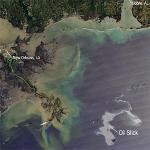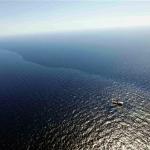29 April 2010

Photo: NASA
Satellite image of the oil spill in the Gulf of Mexico, 25 Apr 2010
The latest estimates suggest 5,000 barrels (795,00 liters) of oil per day are flowing from the damaged pipe that was connected to the Deepwater Horizon oil rig, before it was damaged and sank on Friday.
Officials from the Coast Guard and British Petroleum (BP) say they do not think the leak has expanded, rather they say the new numbers are based on more detailed measurements of the leak.
Experts from the National Oceanic and Atmospheric Administration (NOAA) are gathering data on the size of the oil slick and a variety of other factors to monitor the disaster.

AP
In this aerial photo taken over the Gulf of Mexico, a boat and crew work in oil which leaked from a pipeline at the Deepwater Horizon oil rig off the coast of Louisiana, 26 Apr 2010The top official on scene, Coast Guard Rear Admiral Mary Landry, says the initial estimate was only 1,000 barrels a day.
"This is not an exact science when you estimate the amount of oil," said Landry. "However, NOAA prefers we use 5,000 barrels a day as an estimate of what has leaked from the source and will continue to leak until BP secures the source."
Representatives for British Petroleum, which leased the rig, say they are working as fast as they can and using every tool available to stop the oil leak. The oil company has welcomed an offer of assistance from the U.S. military.
The main objective is to close a massive valve at the base of the rig, which was supposed to shut off in case of emergency, but apparently failed to do so.
Estimates from late Wednesday showed the slick was about 25 kilometers from the Louisiana coastline and would likely reach shore by late Friday.
Marine experts say the growing oil slick will likely have a serious impact on biological life along the shore and in open waters of the Gulf of Mexico.
Steve Lohrenz is a marine biologist at the University of Southern Mississippi, which is near the spill. He says the damage could include several national park areas and other sensitive ecosystems.
"We have the barrier islands off the coast of Mississippi, in Louisiana, the Chandeleur islands. These are pristine areas, and they are also habitat for a lot of marine wildlife," noted Lohrenz.
Commercial fishermen have expressed concern that the spill may ruin the fishing season for shrimp and oysters, which is a key economic activity along the Gulf coast. Steve Lohrenz says the spill has come at a delicate time, shortly after the start of the commercial fishing season.
"It's fishing season, growing season," added Lohrenz. "This is not a time you want to put additional stress on organisms."
Lohrenz says the University of Southern Mississippi is working to expand a network of coastal radars to monitor the oil slick as it continues to expand. He says marine scientists and fishermen along hundreds of kilometers of Gulf coastline are watching to see what impact the slick will have.